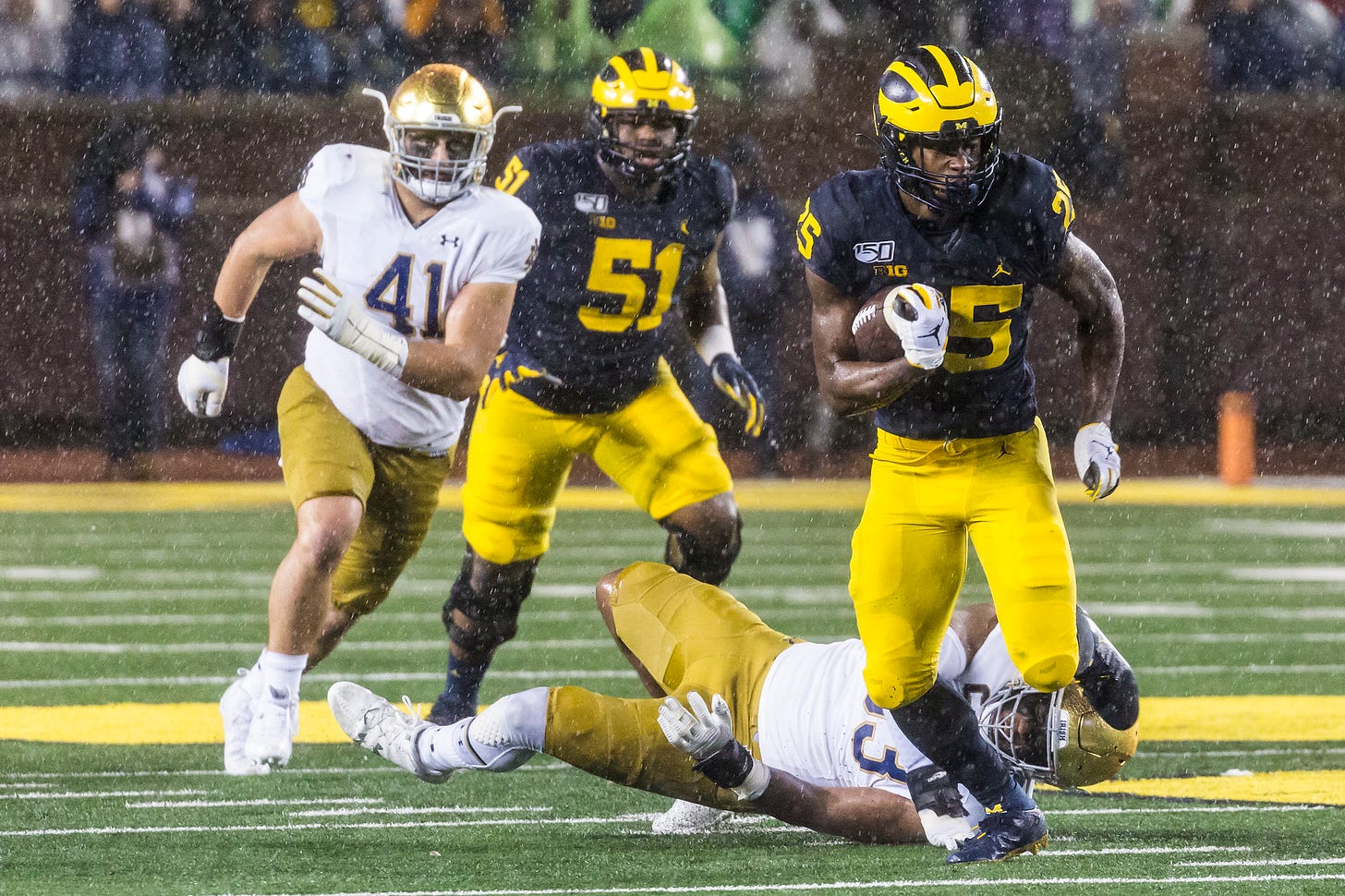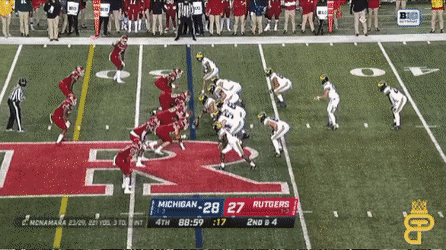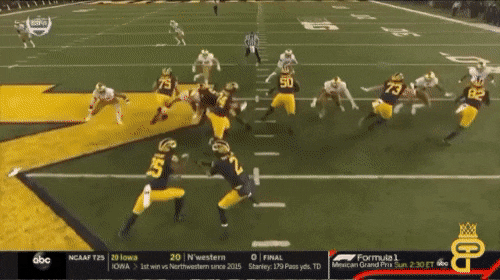We're Overlooking Hassan Haskins, Again
Michigan's senior doesn't have the blue chip prospect profile of his teammates in the running back room. He keeps outproducing them anyway.
Watching Jrue Holiday help the Milwaukee Bucks win the NBA title reminded me of Hassan Haskins.
Hang with me.
Holiday isn’t any sort of basketball prototype. He’s a stout 6’3, plays below the rim, isn’t really a point guard, and isn’t really a shooting guard. While he’s worked his way to becoming an average three-point marksman, opponents often give him the outside shot, and it abandons him for long stretches. He’s prone to blowing open layups.
Playing against Holiday also looks about as enjoyable as being locked in a closet with several poisonous snakes. While Giannis Antetokounmpo made plays that could only be made by the best basketball league’s most astonishing physical talent, Holiday made the Phoenix Suns miserable by doing mean playground shit.
He ripped the ball out of the hands of the Point God, Chris Paul. He smacked Devin Booker’s broken nose while defending him 65 feet from the hoop. He elbowed his way to six boards a game. He only shot 36% during the series but seemingly every make felt monumental. He played at an All-Star level, even if a player of his style wouldn’t get selected to the All-Star game.1
Hassan Haskins isn’t a prototype, either. Listed at 6’1, 220 pounds, he looks tall for a speed back and thin for a power back. He ran a 4.74-second 40-yard dash in high school, which contributed to his nondescript three-star rating. Michigan extended his only Power 5 offer other than Purdue; Memphis, Ohio, and Western Kentucky represented the best of his other offers. Home-state Mizzou didn’t come calling.
Haskins was the second running back in U-M’s 2018 class behind Christian Turner, whose signing required an extended battle with Notre Dame. In 2019, they added top-50 overall prospect Zach Charbonnet to the backfield. The 2020 class contained another All-American back, Blake Corum, and this year’s includes yet another in Donovan Edwards.
The others have been given every opportunity to make their mark. Haskins led the team in rushing each of the last two seasons anyway. Turner and Charbonnet transferred for more playing time.
That’s because Haskins is a rolling maelstrom of blunt objects. Tackling him up high isn’t an option unless a defender wants to be on the wrong end of an embarrassing stiff-arm. Tackling him down low can work, eventually, but it’s a commitment.
I’ve been as guilty as anyone in conducting the hype train for the blue chip running backs. I loved Charbonnet’s high school film and thought he’d be an all-conference player sooner rather than later. I was excited to see Corum get the first touch of the 2020 season, especially when he turned it into a 20-yard gain.
Over the course of the season, however, it became clear that Haskins was the team’s most consistent and effective offensive weapon. Breakaway speed is nice; first you have to be in a position to break away. Haskins may not have been turning 30-yard runs into 70-yard touchdowns but he regularly took contact at three yards before grinding out an extra five.
Still, I’ve found myself talking a lot about the potential of Corum and Edwards, and I know I’m not alone. Both younger backs went off the board before Haskins in our podcast’s roster draft, for which I was just the moderator. It’s understandable to an extent—they’re exciting players with versatile skills that should stand out not just in college but to NFL scouts.
Haskins isn’t being mentioned much in draft circles. He’s not getting a lot of hype in the conference, either. Most preseason All-Big Ten teams I’ve come across have Minnesota’s Mohamed Ibrahim and Iowa’s Tyler Goodson on the first team, and many place the likes of Ohio State’s Master Teague and Wisconsin’s Jalen Berger ahead of Haskins as second-teamers.
Let’s play around with some blind stat resumés from last year, which is admittedly a small and volatile sample, but it’s what we’ve got. I’ve taken a selection of the top returning RBs in the Big Ten and compared their individual rushing stats to the numbers (with sacks removed) put up by the rest of their team. While not a perfectly sound statistical exercise by any means, it’s an interesting jumping-off point.
Player A: 89 carries, 449 yards, 5.0 yards per carry, 6 touchdowns
Rest of Team: 165 carries, 1321 yards, 8.0 YPC, 10 TD
Player B: 201 carries, 1076 yards, 5.4 YPC, 15 TD
Rest of Team: 84 carries, 359 yards, 4.3 YPC, 4 TD
Player C: 61 carries, 375 yards, 6.1 YPC, 6 TD
Rest of Team: 119 carries, 414 yards, 3.4 YPC, 6 TD
Player D: 143 carries, 762 yards, 5.3 YPC, 7 TD
Rest of Team: 142 carries, 680 yards, 4.8 YPC, 11 TD
Player E: 60 carries, 301 yards, 5.0 YPC, 2 TD
Rest of Team: 221 carries, 923 yards, 4.2 YPC, 11 TD
Player F: 104 carries, 540 yards, 5.2 YPC, 3 TD
Rest of Team: 208 carries, 1109 yards, 5.3 YPC, 6 TD
Player G: 137 carries, 462 yards, 3.4 YPC, 8 TD
Rest of Team: 93 carries, 282 yards, 3.0 YPC, 2 TD
Some of these may jump out as obvious: Player A is Teague, whose numbers were surpassed by a potential NFL starter in Trey Sermon, which wouldn’t be a huge knock but for the size of the gap. Player B is Ibrahim, who deserves his hype as the top back in the conference, especially given his massive workload.
Player C, the one with easily the largest improvement over the rest of his team? Yes, that’s Haskins. The others, in order: Goodson, Berger, Illinois’ Chase Brown, and Indiana’s Stevie Scott. (Yes, the Hoosier O-line was rough last year.)
It’s worth reiterating: Haskins averaged 6.1 yards per carry within the context of the 2020 Michigan offense. I don’t need to remind you how difficult that was to achieve. We’re trying to stay positive here.
Haskins hasn’t spent his career overpowering subpar defenses before running into walls against the good ones, either. He ran for 101 yards and two scores on only 17 carries against Penn State last year. His signature 149-yard performance versus Notre Dame in 2019 featured multiple highlight runs. He picked up 6.5 yards per carry against the Buckeyes before the game script dictated a pass-heavy attack.
Speed is overvalued at running back, particularly over long distances. Initial burst, balance, and strength are more important on the vast majority of carries. Few people know this better than Michigan’s new running backs coach; Mike Hart still holds the school record for career rushing yards and he ran a 4.77 40 at the NFL combine.
Haskins isn’t going to lead the billing heading into this season. He’s not going to get the most attention from Mel Kiper. He might not even get the first snap of the season.
I’ll be surprised if he doesn’t lead the team in rushing, however, and so long as the coaches give him enough carries, second-team all-conference could be closer to his floor than his ceiling. Smashing faces 15-20 times a game can do a lot to open up space for the sub-4.7 speedsters. With Hart on the sideline, Haskins may not be overlooked much longer. That’s not what opposing defenders want to hear.
Thank you for reading The Bucket Problem. The site is proudly sponsored by Homefield Apparel. Use promo code BUCKETPROBLEM for 15% off your first order.
Holiday’s only All-Star appearance came in 2013, when he was the #1 offensive option on a bad Philly team with a supporting cast led by Evan Turner, Thaddeus Young, and Spencer Hawes. They finished with the #26 offense out of 30 teams—but also the #15 defense, despite a terrible roster.









Well done. This take is spot on. Haskins is always overlooked, but every time he gets the ball he is both a bucket and a problem. I hope they ride him this year. If the o-line takes a step forward and he gets enough carries, he could have a special year.
It honestly drives me nuts - and I hope it does the same to him - that he's basically not even mentioned except in passing. Thanks for giving him some love here, Ace ... That 6.1 YPC within the offensive year from hell is the perfect encapsulation of what he does, which is just get it done.